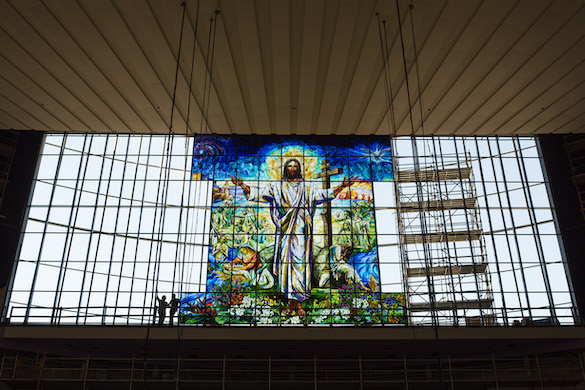
* * *
What, you might ask upon perusing the title of Justin Monroe’s documentary, “Holy Frit,” is frit? That there’s a play on words going on is obvious, but not so much when it comes to the words being played with. “Frit” is vital to Mr. Monroe’s story of over-scaled ambitions, material frustration, and an ultimate compensation that is, in equal parts, financial, aesthetic, and spiritual.
Laymen in the audience learn about frit almost tangentially as we watch Narcissus Quagliata — yes, that’s his real name — sprinkle a granular mixture of something or other upon flat shards of colored glass that are then placed in a kiln. Pace the ever reliable Miriam Webster, frit is “various chemically complex glasses used ground especially to introduce soluble or unstable ingredients into glazes or enamels.”
As seen in Mr. Monroe’s picture, frit occasions a painterly range of color and texture that is then combined with “fused glass,” a specialized technique that is Mr. Quagliata’s contribution to the medium. The renowned glass artist is the secret weapon of Judson Studios, a family-owned business based at Los Angeles. Mr. Quagliata is called in for his expertise when the company lands a bid to make the world’s largest stained glass window and subsequently realizes that it’s taken on more than it can handle.
Along with his expertise, Mr. Quagliata brings an abundance of pithy opinions, hackle-raising behavior, and sizable stogies that are perpetually at hand. Even without “the Maestro” and his jet-setting ways, Judson Studios is undergoing enough stress prompted by the multimillion-dollar commission.
David Judson, its fifth-generation owner and operator, is an even-keeled sort who loathes to give in or admit to his anxieties. All the same, he betrays grizzlement as the project progresses. As for Tim Carey, the painter in Mr. Judson’s employ who lands the job with the United Methodist Church of the Resurrection, the press release describes him as “a bit of a jackass.”

* * *
Only a bit? Mr. Carey has a forbearing wife and beautiful children, but, boy, is he a piece of work. We first encounter him at the wheel of his car, semi-facetiously bemoaning the artist’s lot in life, rattling on about being the suburban kid amongst a cadre of weirdos in art school. A talented painter with a sense of humor, Mr. Carey is also headstrong and prickly. He can’t help but betray his frustrations — and his snark — when dealing with his boss, co-workers, Mr. Quagliata, and the representatives from the church.
Still, they all muddle through. The folks from the United Methodist Church of the Resurrection — you might remember its pastor, Adam Hamilton, from the second inauguration of President Obama — are a remarkably patient lot. Which isn’t to say that there aren’t snags. Money problems are encountered, but so too are lawsuits, bureaucratic snafus, and accusations of environmental poisoning. That, and Mr. Carey isn’t spending enough time with the kids.
Yuchiro Oku’s soundtrack, jaunty and loud, telegraphs the dramatic trajectory of the story, as does Mr. Monroe, whose light, almost farcical touch similarly undermines “the drama of any human endeavor that is greater than the sum of its parts.” Still, he’s crafted an amiable film that is most compelling when settling its lens on the benefits of community — whether it be the members of Pastor Hamilton’s flock or, especially, the employees of Judson Studios.
In the end, “Holy Frit” underlines its abiding humanity by straying from its primary storyline.
(c) 2023 Mario Naves
This review was originally published in the October 27, 2023 edition of The New York Sun.
Trackbacks
[…] Maev Kennedy reviews a new biography of Irish stained-glass pioneer Michael Healy (The Art Newspaper), Dan Hitchens reviews The Illuminated Window: Stories Across Time by Virginia Chieffo Raguin (The Spectator), and the documentary film Holy Frit explores the world of renowned stained-glass maestro Narcissus Quagliata (Too Much Art). […]